Depending on the types of locations where you typically shoot, using your vehicle as a mobile blind for photographing birds may be a viable, even perfect option for you. Perhaps the biggest obstacle to great bird images is getting close enough to them for good image quality and birds generally don’t allow a close approach by photographers on foot. But in many locations birds have become acclimated to vehicles and traffic so using your vehicle to get close to them makes sense. And it works! Most of my shooting is done from my pickup. Birds often seem to pay no particular attention to humans inside vehicles but that changes so very quickly as soon as you open your door.
One of the testaments to the fact that birds don’t like close approach is the bundle of cash photographers are willing to lay down for high quality super-telephoto lenses but even if your investment in gear is a modest one you’ll want to protect it in the vehicle as you traverse bumpy roads and make quick stops as you search for birds (it definitely gets your attention the first time your lens and camera, resting on the car seat, crash to the floor when you hit the brakes). But you also want it available for use on a moment’s notice and not strapped down so that it takes time to retrieve it. Believe me, birds don’t wait for photographers.
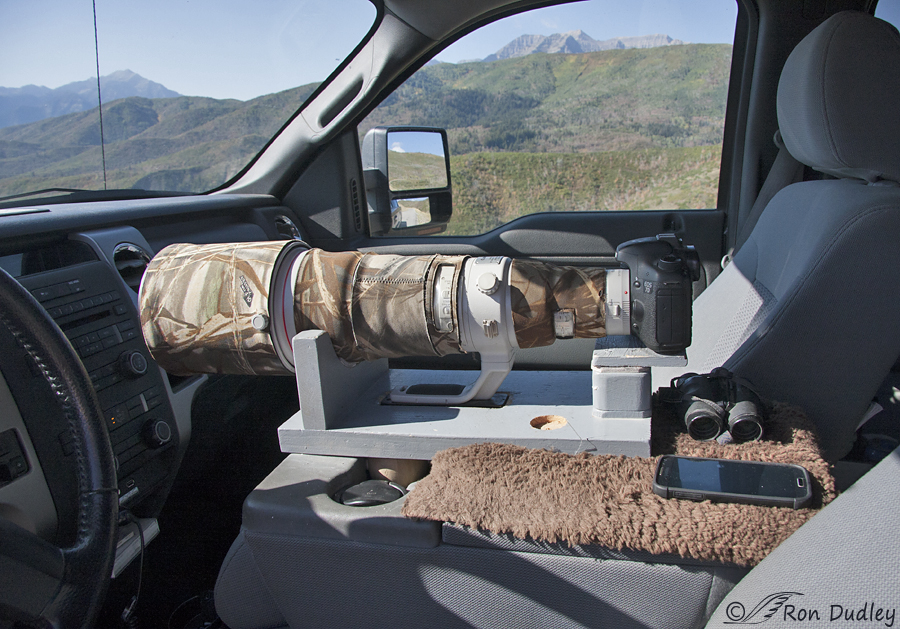
So here’s my personal solution to that problem. I call it my “lens caddy” and I absolutely love it. It carries my lens with attached camera body securely but yet when I need it I simply reach under the lens and instantly lift it out. The caddy fits on my folded down center console – if you look carefully you’ll see that it’s secured with wood pieces that fit tightly into cup holders in the console. The lens foot fits into a precisely cut rectangular slot that I cut into the base of the caddy, the front of the lens is supported by a curved wood piece with attached felt pads for protection from abrasion and the camera is supported by another wooden base at the rear.
You’ll also notice a small, circular cut-out in the base of the caddy. A circular projection on my teleconverter fits into that cutout when I remove it so that it won’t slide around or drop to the floor (or into the door side-pockets as has happened in the past). I always place the tc into that cutout with the “red dot” pointing the same direction – that way I don’t even have to look to check its orientation when I grab it and it goes back on in an instant (time is usually of the essence and I don’t want to be fumbling around with the tc).
I’ve used this same caddy for 7 years now, though I’ve modified it several times to fit three different vehicles (two pickups and one small car) and several camera/lens combinations. With all the crazy maneuvers I’ve done on rough, dirt or gravel roads in that time my lens has never come out of the caddy. At most, on the roughest roads (and I do mean rough), I’ll momentarily rest my hand on top of the lens to help stabilize it a bit.
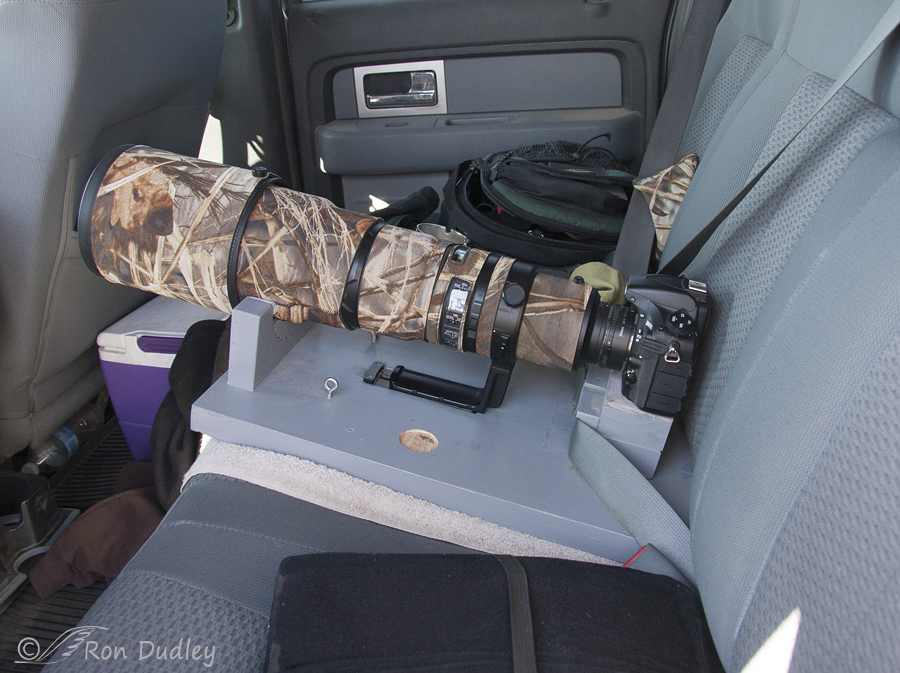
I also built a lens caddy for Mia who rides in the back so we can both shoot the same direction out the windows. Her caddy is secured tightly to the seat at back by the middle safety belt and at front by a bungee cord that hooks under the seat and to the front of the caddy. Since she rides in front when there’s no immediate possibility of birds there’s also a small bungee cord that wraps over the top of her lens and hooks to the eye-bolt that you see in the photo. That cord secures her gear even better while she’s riding in front.
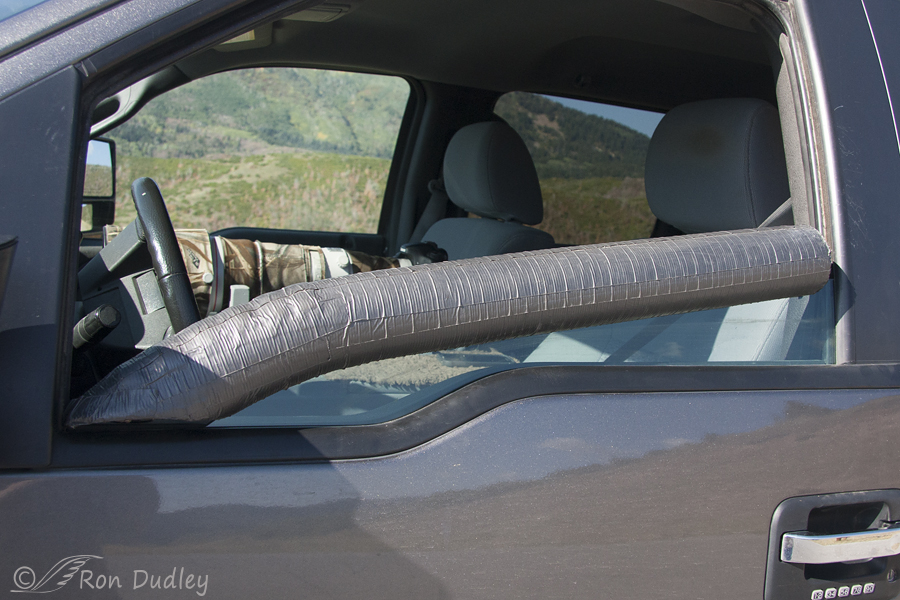
If you’re shooting out the window you need something to support and protect your lens and dampen vibration. I’ve used a variety of “gadgets” over the years but never found anything better than my “Noodle” (Mia came up with the idea). It’s one of those swimming pool “noodles” that kids like to bash each other with but we put them to a more productive use. They have a hollow core so we cut them to length, slit the bottom so they fit over the window glass and then wrap them in duct tape to mute the loud colors and give them more support. The front window in my pickup is deeply curved so I’ve modified it to fit the curve.
Noodles come in a variety of textures and diameters but I prefer the sturdy, relatively stiff ones with a diameter of 3 1/4″. If you decide to go this route you’d best get your noodle very soon – except in warm climates they’re usually not available in the winter months. We sometimes get ours at Wal-Mart (though if we can find them somewhere else that’s where we’ll buy them). Noodles are ridiculously cheap (especially compared to some of the alternatives) and I think they work better. They last for many months and when one wears out I simply replace it. I can get two or three from a single $3 noodle.
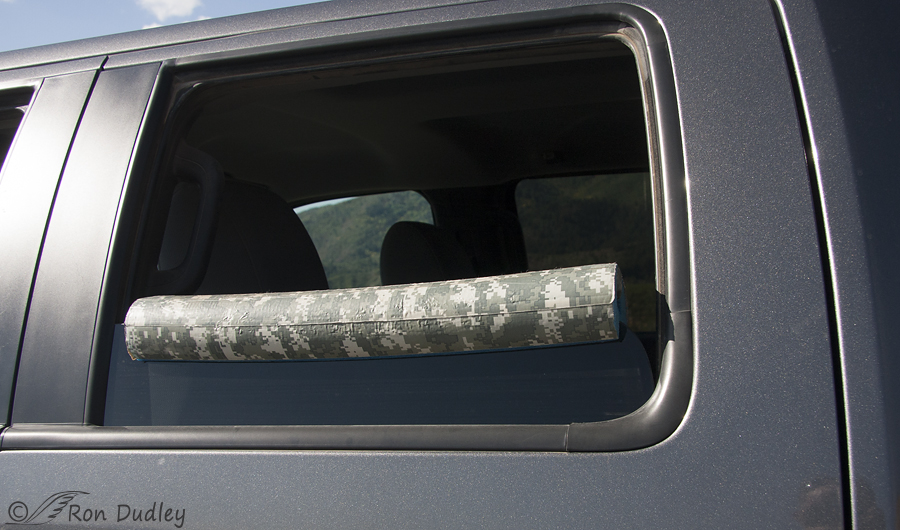
This is Mia’s Noodle on the back window. That window has no curve so the Noodle is easier to make.
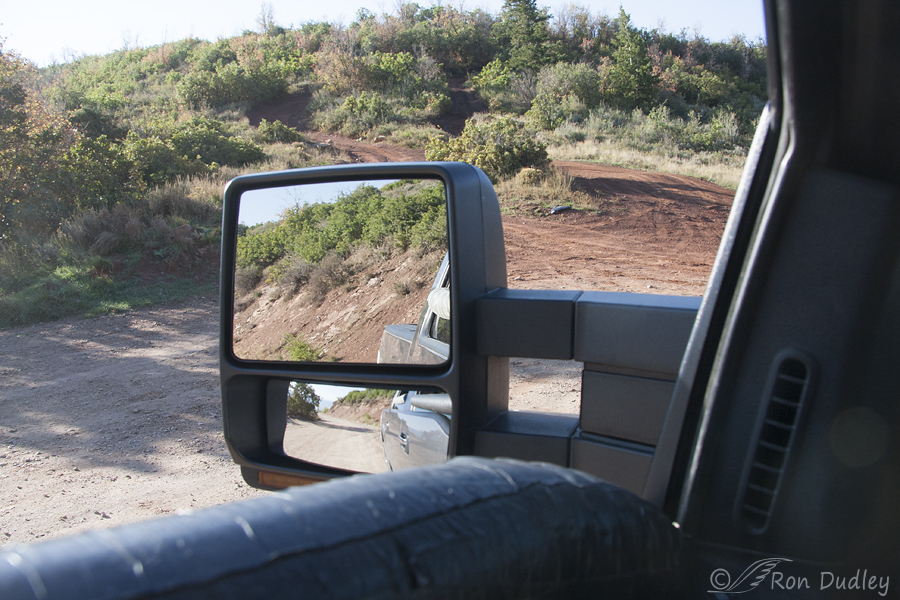
One issue with shooting from your vehicle is the side mirror. As you can see, mine is huge and here it’s not even extended for trailer pulling. The position of the typical mirror is often exactly in the direction that you’ll want to be shooting so it can be very frustrating because the darn thing’s in the way. The problem can be somewhat mitigated by creative driving as you’re approaching your subject but it can never be totally solved (unless you rip the mirror off the door but I suspect that Trooper Mitch Voss of the Montana Highway Patrol would disapprove of that strategy…)
Most folks won’t have mirrors this large and thankfully…
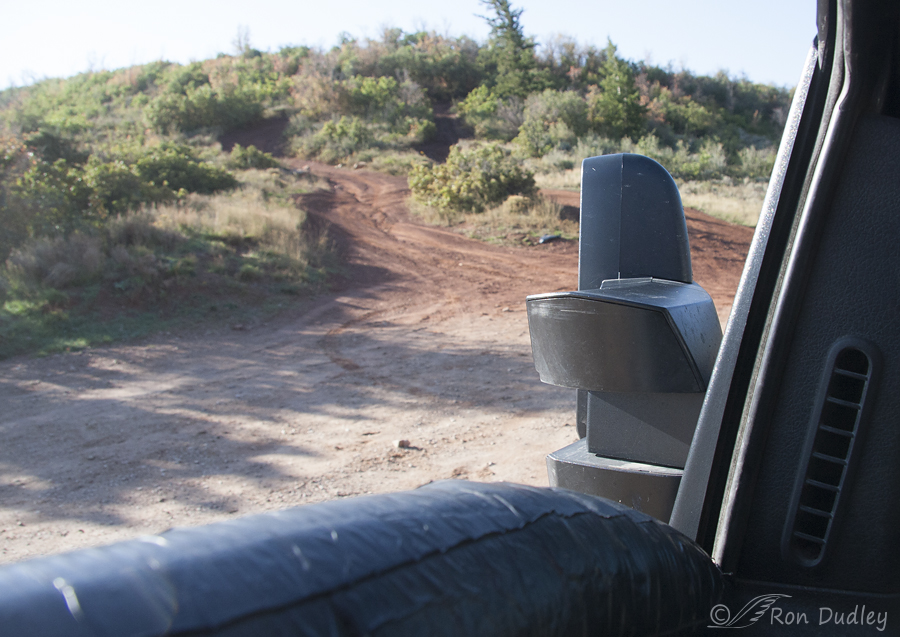
mine can be folded back and mostly out of the way but even in this position it can occasionally be a pain in the butt.
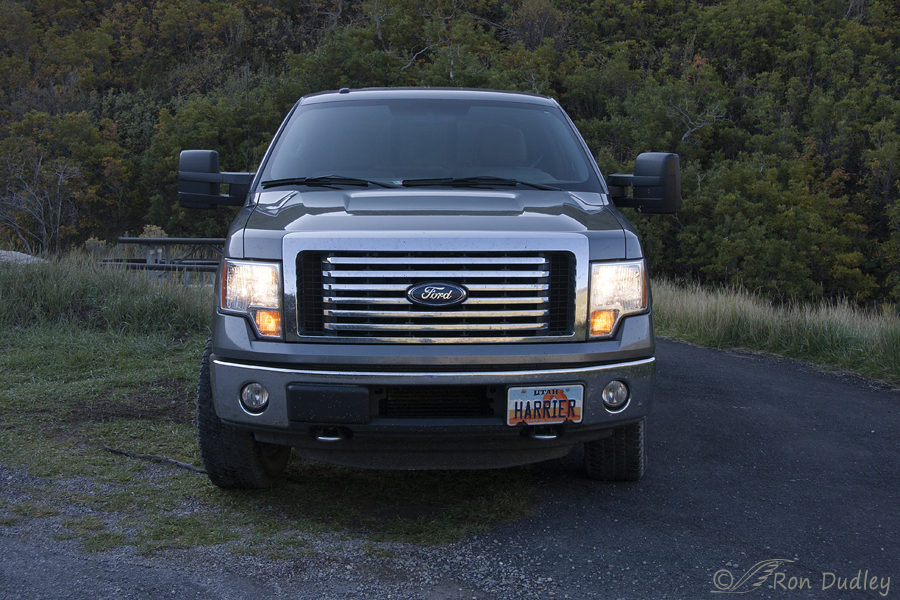
I’m often surprised by the number of bird photographers I see cruising for birds with their lights on. As skittish as birds are I don’t want any added element that might flush them or make them hide. I once had a Toyota Matrix that had daytime running lights that could not be turned off – they drove me nuts! I tried putting duct tape over them (not practical) and bribing the dealer to rig a system for turning them off (he refused). I understand that some folks can’t turn them off but I’m pretty sure that many who don’t, can. If you can I’d suggest doing so, especially during low light in the morning or evening.
I’ll never buy another vehicle with daytime running lights that can’t be turned off (in my current pickup they can be). I would also never buy a vehicle where the back windows don’t roll all the way down, for obvious reasons (thanks to Facebook friend Christine Bogdanowicz for the reminder about that last little tidbit – she just returned from an extended trip “out west” and by mistake rented a car whose rear windows didn’t roll all the way down, which she regrets).
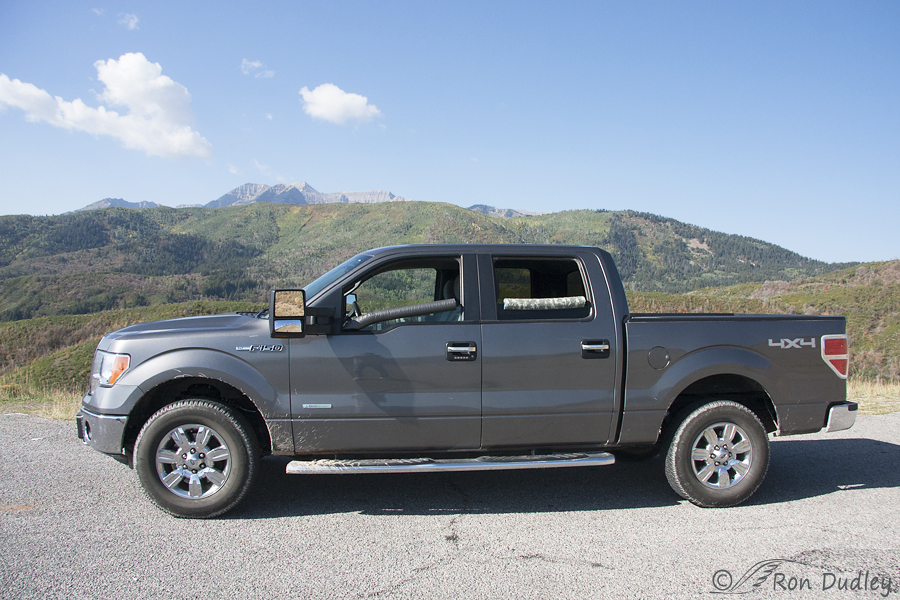
So here’s a look at my entire “mobile blind”, complete with Noodles in place, mirror pushed forward and mud and dust from my recent excursions – yesterday’s was Cascade Springs and the Alpine Loop.
Here are a few additional tips and suggestions for shooting from your vehicle:
- If you have a tripod, bring it along for those situations that require it. We keep ours under the back seat.
- Shooting from a vehicle doesn’t require that it be a high pickup – small cars work just fine and have the advantage of a lower shooting angle for birds on the ground or in the water.
- If practical for the situation always turn the engine off before shooting. Running engines can cause vibrations that contribute to soft shots, particularly with long lenses
- If you wish to avoid making enemies for life, do not get out of your vehicle while near other photographers shooting birds from their own vehicles. Even cracking your door open will often flush the birds and make your fellow photographers very unhappy (and that’s an understatement)
- You’ll be spending lots of time with the windows open as you cruise and listen for birds and especially when you’re actually photographing them, which means you’ll be exposed to the elements. Dress accordingly. During winter we always carry hats, gloves, chemical hand warmers (which we stuff into the gloves and sometimes into our socks), and even blankets to put over our laps. Even so it’s not unusual for us to get so cold our shivering makes photography a challenge.
- Don’t breathe on the viewfinder in cold weather. If you do you’ll have to wait for the condensed moisture to evaporate before you can see through it again
- Open windows mean nasty biting bugs have full access to you. Nothing can ruin great opportunities with birds faster than mosquitoes, horse flies, deer flies and biting gnats (no seeums). We carry bug repellant in the door pockets but it is only marginally effective on some species so expect to be bitten. I call it “itching and bitching season”.
- We nearly always shoot in the morning and we’re both coffee addicts. Coffee (caffeine) is a diuretic so plan accordingly. If you’ve gotta go you’ve gotta go and it’s very disappointing to have to leave a productive location in search of a bathroom (personally, I get creative about that when I can…)
If you decide to try using your vehicle as a mobile blind I wish you luck and happy shooting!
Ron


Great tips – thank you! Now I’ve got to rush out and buy a noodle before the snow hits!
Fascinating Ron! I have wondered how exactly it works with the two of you in the vehicle. So I guess you plan your route to have the best photo possibilities on the driver’s side of the vehicle?
Ken
That’s exactly our game plan, Ken.
I do not have such a big lens and normally I am alone in a car without a center console. I often set the camera my binoculars on the seat, but hook the strap on this http://www.pbase.com/xiboia/image/157576776
to keep them from sliding off. Sometimes I use a bungee/shock cord or a carabiner.
This is a fantastic post, Ron. I appreciate your and Mia’s generosity with what is sometimes hard-earned knowledge. I started using a noodle about a year ago when you mentioned it and included a link to one of Mia’s posts on the subject. It’s made a huge difference. Also, I run into the mirror issue fairly often. I’d love to make myself a lens caddy. I haven’t tried it because often I’m not in my car. Your solution for Mia’s caddy should work on many vehicles and I think I’ll give that a try. Thank you again.
Have you tried foam pipe insulation for the window? It’s available all year, is cheap, is already gray, and is pre-split. I’ve had it (wrapped in duct tape) on the upper segments of my tripod for years. It provides some padding for my shoulder when carrying tripod and camera and is a warmer, non-metallic surface for my hand in winter.
Larry, yes, I’ve tried it. In fact that’s what I started out with before Mia suggested the noodle but the foam pipe insulation broke down very quickly under the weight of my 500 mm lens against the relatively sharp edge of the glass. Noodles seem to hold up much better.
A testament to determination and ingenuity. Thanks Ron.
Thank you, Elephant’s Child. Maybe to stubbornness and obsessiveness too…
As a pig-headed obsessive some days I don’t think there is a lot of difference between determination and stubborness. Depends on who is handing out the label.
WOW – Great info Ron, many, many thanks. Where did you get the camo noodle? I need to find a dark one since my grand kids only had a bright green one. Our biggest frustration is traffic and a lack of open spaces, but that is typical in the east. We do have a favorite some distance from us, otherwise wait for an early morning ride in winter when the Snowys and Roughys are out and about.
Again, many thanks for a very informative post, much appreciated!
Thanks, Dick. As far as I know all noodles come in neon colors which I dislike. I wrap mine in duct tape which has all kinds of designs, including camo.
Another thing to consider is a shade on window you are not looking, preferable something the same color as you clothes. Your silhouette through the window can often scare birds. This is especially important if you park by lake and want critters to approach you.
Thanks for the suggestion, Rick.
Really like your holders you made. Thanks for sharing, I have limited mobility and often shoot from the truck. I appreciate your observations some things I had not considered before…turning off the vehicle(DUH)! Thanks again and happy shooting!
Ashton, my mobility is not limited and I still usually prefer to shoot from my truck. Overall, in the places I usually shoot, that method is the most productive.
Great ideas! Thanks again to both you and Mia for the noodle idea which I’ve been using for over a year now with good results. Love all your other tips!
Thanks, Wally. I remember that you’ve been using a noodle for a while. Glad it’s working well for you.
I wonder if an electrician could do something about those “running lights”… Or clever mechanic…an electrician friend fixed our van so that the doors could be kept open and lights would not go on unless you flipped a seperate switch, which he installed..I wouldn’t expect a dealer to be willing.. Thanks for sharing such helpful, practical tips…esp.use of caddy and wrapping noodle with tape…otherwise they sometimes tend to shed little, static cling pieces…doubt if birds are aware of bright colors…but, you never know…As for side view mirrors, some won’t bend out of the way at all…so try a hatchet, small sledge or dynamite….works on my iPad!!!
I’m still chuckling (nay, guffawing) over your iPad comment, Patty. The birds may not be aware of those neon noodle colors, but I am. After all, I do have a reputation to protect…
I love all or your ideas!! Pretty cool!! I love to improvise too!! 🙂
Thanks, Gail. For those interested, Gail has come up with her own idea for lens storage in a mobile blind, Facebook link here – https://www.facebook.com/photo.php?fbid=10204225226223368&set=a.2618854963163.128939.1608819419&type=1&theater
WOW so many ingenious and useful ideas. I will try to put them into practice.
Thank you very much.
Good luck, Jorge. I hope they work for you.
Excellent suggestions, I’ve been using noodles but never thought about covering it with tape. I also use a molar bag from a pattern I found on the internet and filled it with bird seed. I don’t use bug sprays because I would probably get it on my lens. Thanks for doing this blog it is a great source of information and your images are excellent. Thanks
You’re very welcome, Craig. Thanks for the feedback.
You are so kind to share your wonderful tips! Greatly appreciated. I have learned much from them. I wish there was a way to solve the problem of running lights on my Toyota. 🙂
Thanks again!
Charlotte
Charlotte, actually it was our email discussion on this subject a week ago that partially inspired me to do this post. Thanks for that!
Fascinating and most generous of you to share. I love being able to see (the casing of) the lenses that bring me your photos each morning. As a designer I’d love to create a bug netting ‘blouson’ for your car windows through which your and Mia’s lenses could protrude… but I’m not sure if my brain cells are up to the task. I’ll keep you posted!
Thank you, Alison. That lens “casing” is called a Lenscoat (a soft, neoprene cover). Though it’s camouflaged its primary purpose is to protect the lens (a very large investment). I’m not sure a “blouson” would work because I suspect it would obstruct vision and in addition our lenses need to be able to slide horizontally the entire width of the windows. But thanks for the thought – very much appreciated that you even mentioned it.